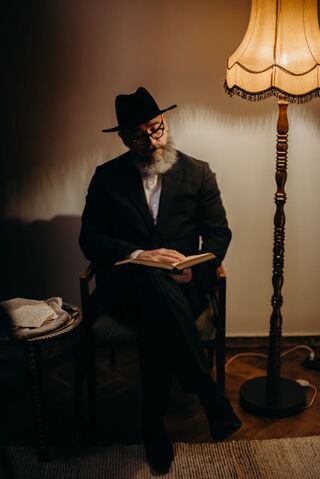Domestic Violence
Ultra-Orthodox Jews, Domestic Violence, and Coercive Control
How to help Ultra-Orthodox domestic violence survivors choose their own path.
Posted October 26, 2020
“When I left my husband so my kids and I could survive, the community left me.” Thus spoke a heartbroken Hasidic woman, who was rejected by her community when she fled her 16-year marriage to an abusive husband. To help Hasidic abuse survivors and their children, psychotherapists, advocates, judges, and attorneys need to learn about Hasidic norms and culture.
First, a little background. Jews in the U.S. and around the world are diverse. Hasidic Jews form a small but highly visible sliver of the Jewish community, constituting less than 6% of U.S. Jews. Hasidic people (called Hasidim, from the Hebrew), tend to dress distinctively; men typically wear dark coats and hats, and married women wear high-neck dresses and cover their hair with wigs or scarves, for modesty.

Hasidic communities follow a singular leader who they view as their liaison to God. Most Hasidim live in communities in Israel or in the greater New York City area. Hasidim often educate their children in private schools called Yeshivas, where they typically teach in Yiddish and Hebrew. Girls are apt to have more of a secular education, including English, while Hasidic boys may not begin to study English until they are 8 years old. Hasidic rabbis try to shield children from modern secular communication through banning television, smartphones, Internet access, non-religious books, and popular music.
Hasidic communities tend to be tight-knit and gender-segregated, relying on the community for all their needs. Many Hasidic communities have robust organizations that serve as safety nets for people with a low income, illness, or disability. While this self-reliance is a community strength, living so disconnected from the secular world also can leave victims of abuse isolated and vulnerable.
Gender Relations in Hasidic Couples

Men and women marry young in Hasidic communities, often as young as the law allows. Hasidic parents typically arrange their children’s marriages and the couple have little say in the choice of their spouses. In most married Hasidic couples, the wives are responsible for all household duties such as cooking, cleaning, and child care. Wives also often earn money within the community but outside the home, at least until they have children. Husbands devote their lives to studying the Torah, and may also work for pay. While this arrangement is traditional, it does not necessarily imply abuse. Many Hasidic men value their wives and treat them well, making their lives easier by providing love and practical support.
However, some Hasidic men have difficulty relating to women, and vice versa. Men may have had little contact with girls or women other than their mothers while growing up. The lucky ones have had models of loving relationships in their homes. The less lucky ones enter marriage unprepared to be caring partners. Hasidim typically have no sexuality education and no training in consent or sexual relationships, which can lead to regular coercive sexual encounters in marriage, even "unintentional rape."
Highly observant Jews obey 613 laws regarding all aspects of their lives. Many Hasidic men believe it is their role to force, cajole and corral their family members into adherence. The culture is also highly patriarchal, with men's opinions and goals seen as more valuable than women's. While female subservience is expected in many families, this is different from the extreme domination of coercive control. That is, while some Hasidic men try to justify their coercive control and even physical violence with cultural explanations, neither their religion nor their culture justify this kind of domination of their wives.
When Hasidic Husbands Abuse Their Wives
What happens when a Hasidic husband abuses his wife? Her family and friends are apt to tell her not to complain or make trouble, to preserve the marriage. Hasidic rabbis aim to keep families together and maintain the community, so they often urge abused women to be patient. They may counsel husbands to stop engaging in physical violence because it is not permissible in Judaism. However, most rabbis do not understand other forms of abuse such as coercive control, and economic or sexual abuse in marriage.
Many abused Hasidic women do everything in their power to make their marriages work. Some tolerate the abuse in silence throughout their lives, knowing they will be blamed if word gets out. If abuse victims ultimately decide to end their marriage, they know they risk being shunned, shamed, stigmatized, and considered selfish. Any “stain” on the family, such as divorce, makes the children less valuable as future marriage partners. (A Hasidic man who ends his marriage faces similar pressures). Some divorcing Hasidic survivors of domestic abuse try to stay in the community, but they may be pushed out since their rabbis and friends shun divorce.
After separation, the community may continue to pressure the survivor of domestic abuse. An abusive father might elicit community support to help him fight for child custody by slandering his children’s mother. Some fathers have raised hundreds of thousands of dollars to pay for their attorneys by using GoFundMe Campaigns in Yiddish, at times including false allegations that a mother is abusive or is converting their children to other religions.
How the Secular Courts Handle Divorcing Hasidic Couples
While each situation is different, a New York Times article described how contested custody in Hasidic communities often works:
1. The Rabbinical court (Beth Din) grants custody to the mothers, who agree to raise the children in extremely observant conditions.
2. Secular family courts must determine the best interests of the children, but generally defer to the agreements made by the parents in the Beth Din, obligating mothers to maintain a high level of religiosity as a way of “maintaining the status quo.”
3. Shunned by their community and needing employment, the mothers often further their education and/or work outside the home, expanding their horizons and sometimes leading to less religious observance.
4. Community members including family may stalk and harass the mothers, spying on them, taking photos through their windows, and trying to “catch” the mothers doing something that breaches religious requirements such as allowing their hair to show, not keeping the Sabbath, or permitting the children to speak with people outside the community.
5. The fathers then fight for custody, sometimes successfully, claiming the custody agreement has been violated. Some courts have succumbed too easily to this kind of argument, mistakenly giving heightened value to maintaining the children’s religiosity over the importance of children staying with the non-abusive parent who has provided most of the care throughout the child’s life. (The New York State courts found this unconstitutional in the August 2017 reversal of Weisberger vs. Weisberger).
The court may also assign therapists and lawyers to the children who are closely aligned with the Hasidic community and who overlook a family's specific circumstances, including domestic abuse. The courts may rely on rabbis to assess children’s emotional needs--despite these rabbis' lack of secular professional credentials. The secular courts then sometimes serve as tools of post-divorce religious coercion, mandating the mother's religious observance with the implied or overt threat of, "You risk losing your children if you become less observant."
Helping Hasidic Survivors Escape Abuse
Keep the following issues in mind if you are trying to help a Hasidic domestic violence survivor who is freeing herself from an abusive partner:
Community: A woman who leaves her abusive husband may be shunned by her Hasidic community and family, and therefore needs new formal and informal supports.
Dietary and Sabbath Needs: Observant Jewish women who are fleeing abuse may have special dietary restrictions and may need to engage in certain activities on their Sabbath and holidays, while avoiding others. These religious mandates should be honored wherever they are seeking shelter.
Interpersonal Dynamics: People who have grown up in small ethnic communities, such as Hasidim, may have initial difficulty interacting with people from other groups. They may feel insecure and unsure of social norms. Even those who have spent their entire lives in the U.S. may not speak English well, and may need the kind of help with daily life that one would offer to refugees from another country.
Lack of Financial Resources: When fleeing an abusive partner, Hasidic women are often not only financially impoverished; they are also not apt to know anyone who is willing to share resources with them. In fact, members of their former communities may try to deprive them of housing and employment.
Fear of Losing Custody and Child Abduction: Hasidic survivors will be terrified of losing their children to their vengeful ex-husbands and communities. They need the help of attorneys, judges, and organizations that understand these dynamics.
Resources that may help:
The Shalom Task Force provides support and education to Orthodox couples, including those facing domestic violence. They have a confidential Hotline and chatline.
Footsteps describes itself as an organization that supports and affirms individuals and families who have left, or are contemplating leaving, insular ultra-Orthodox Jewish communities in their quest to lead self-determined lives. Their website provides a list of resources for people leaving Hasidic communities.
References
Otterman, S. (May 25 2018). When living your truth can mean losing your children. New York Times.




